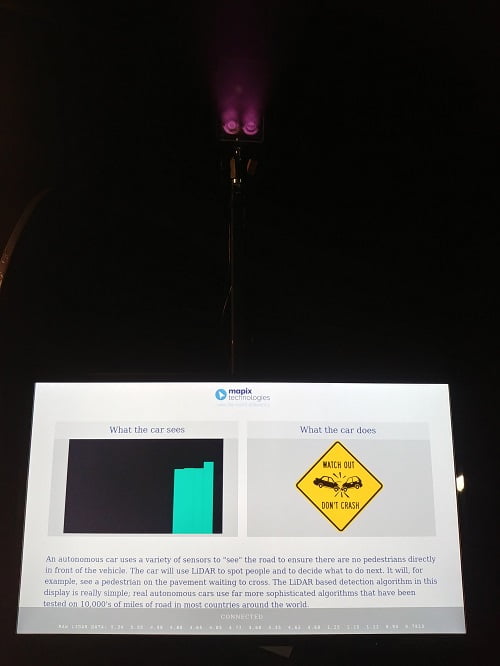New LiDAR and autonomous car exhibition opens at Grampian Transport Museum.
Change is accelerating. These are seriously interesting times for transportation; we are witnessing an historic technological disruption. A few years ago driverless or autonomous cars were deemed rather fantastical… today they are reality.
Mapix is proud to be supporting ‘Probing the Future’, an exciting and sensory autonomous car exhibition at Grampian Transport Museum, Aberdeen, which will explain the technology and advancement of autonomous and electric cars and their associated social impact. Wide ranging from the environmental impact due to a decrease in car ownership, the affect on infrastructure and public transport, to the impact on economics, employment and safety. The exhibition suggests that perhaps we are witnessing the start of the end of the motoring era.
LiDAR, Light Detection and Ranging, is fundamental to the way autonomous cars work. Mapix specialise in LiDAR and our CEO, Gert Riemersma, commented, “The interactive display that we have created with the Museum is called “How the car sees the world” and it uses a LiDAR scanner to replicate pedestrians approaching the vehicle, which then works out how the car should respond and carry out a safe course of action.”
Gert added, “We are already seeing some autonomy in vehicles today such as assisted cruise control, lane assistance, automated parking. The area of autonomous cars is fast moving and exciting and it is great to be able to work with the Museum, our suppliers and partners to be able to communicate the potential of LiDAR to a wider audience.”
See the interactive display in action as a pedestrian approaches the vehicle.

The LiDAR sensor with the autonomous car display
More about the LiDAR display
LiDAR is an integral technology to how autonomous vehicles perceive objects around them. Known as “path planning” LiDAR is fundamental to object identification and classification i.e. assessing exactly what the object is that is in the vehicle’s “sight”, is it a person, another car or part of the street furniture such as a lamp post or traffic light? Once this is understood the vehicle’s computer can decide on the best course of action, which could be to slow down, to swerve or to stop.
The LiDAR display comprises a number of different elements to demonstrate the technology and show how it enables the vehicle to perceive it’s surroundings. Visitors can see what a LiDAR sensor looks like, and how the functionality of different LiDAR models lend themselves to different applications and ways of integrating the technology, with units kindly loaned by Velodyne and LeddarTech. Experiencing what the vehicle actually “sees”, visitors are immersed into a real time pointcloud, which is the 3D image produced by a LiDAR sensor. An interactive LiDAR display will illustrate to visitors how the vehicle uses this 3D pointcloud to identify and classify the object in it’s path and take the most appropriate course of action.
About Grampian Transport Museum
The museum is an educational charity and is a revered example of a museum that addresses relevant and topical issues timeously to change visitor perceptions. The new “Probing the Future” autonomous car exhibition is no exception. The exhibition will be refreshed every three months, such is the rate of change, to keep it absolutely accurate and topical.With help from key stakeholders in the ‘Mobility Revolution’ Grampian Transport Museum have set out the likely time frame for the adoption of autonomous cars and who is leading on this, firstly with ‘Robo-Taxis’ by Uber and others in the big cities and eventually filtering out to rural areas.
To see more about the Leddartech range of LiDAR sensors from Mapix technologies, click here
